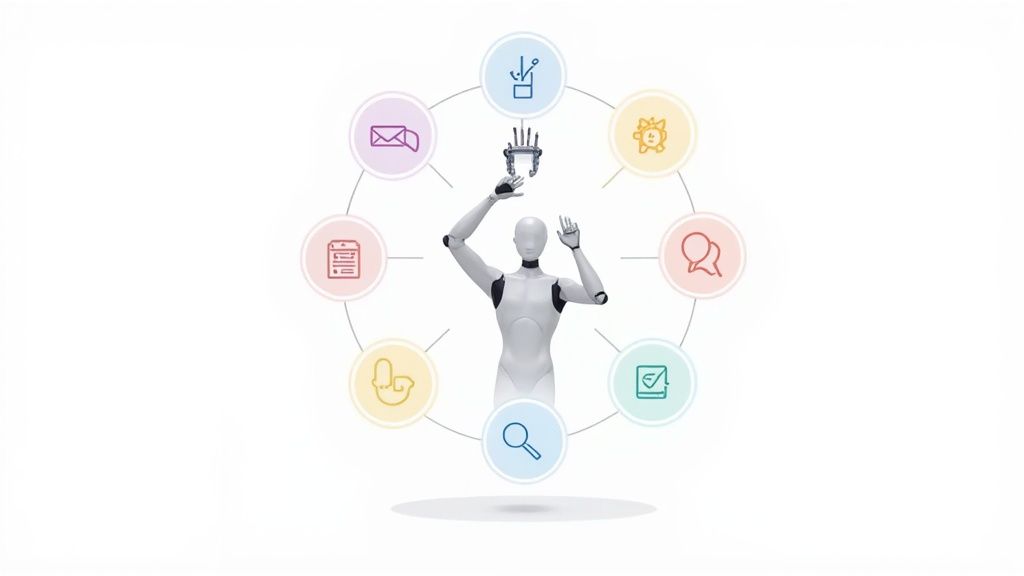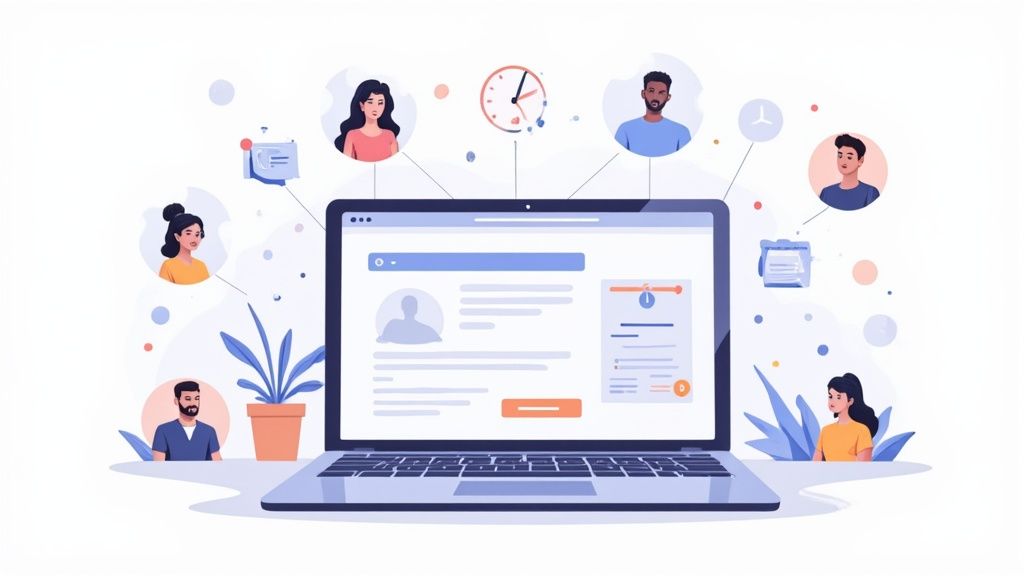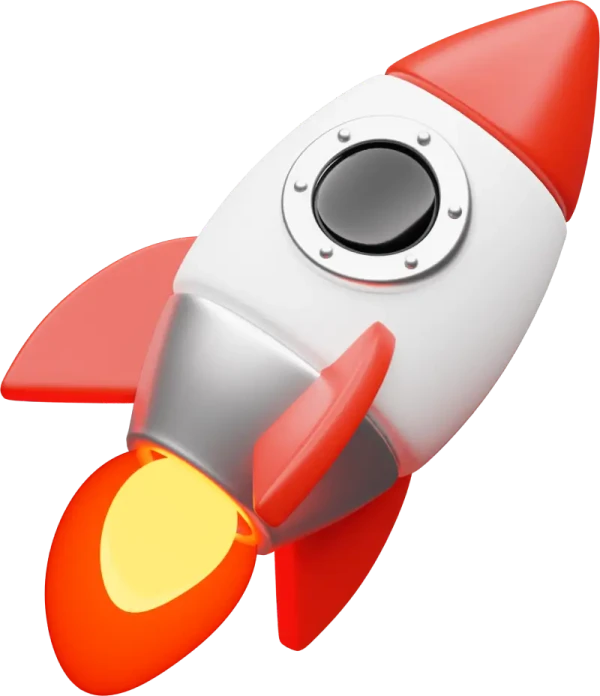Marketing automation isn't just about sending emails while you sleep; it's a strategic framework for building smarter, more scalable relationships with your audience. Yet, many businesses struggle to move beyond basic setups, leaving significant ROI on the table. The difference between a simple autoresponder and a revenue-generating machine lies in applying proven marketing automation best practices. A poorly configured system can alienate customers, but a well-oiled one anticipates needs and delivers value at precisely the right moment.
This guide breaks down the eight most impactful strategies that separate high-performing teams from the rest. We'll move beyond generic advice to give you actionable steps, real-world examples, and the insights needed to transform your automation efforts. You will learn how to implement everything from sophisticated audience segmentation and behavioral triggers to multi-channel campaign coordination that feels seamless to your users.
For event marketers specifically, automating crucial touchpoints like calendar invitations can dramatically boost attendance. Integrating a service like ours into your workflows ensures your event lands directly on a user's calendar, turning a fleeting moment of interest into a confirmed appointment. This is just one example of how a specific, targeted automation can elevate your entire strategy. Let's dive into the core practices.
1. Audience Segmentation and Personalization
One of the most foundational marketing automation best practices is moving beyond one-size-fits-all messaging. Audience segmentation is the process of dividing your broad audience into smaller, more manageable groups based on shared characteristics. Personalization then uses this data to tailor your automated communications, making them highly relevant and impactful. Instead of a generic blast, each contact receives content that speaks directly to their needs, behaviors, and interests.
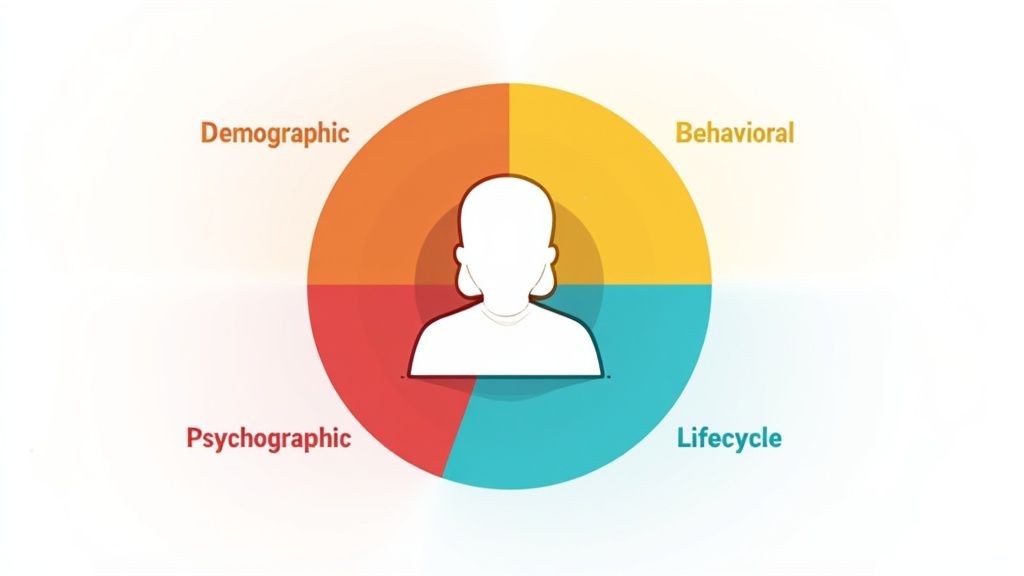
This approach transforms automated messages from robotic announcements into helpful, human-centric conversations. The result is significantly higher engagement, stronger customer loyalty, and better conversion rates. Companies like HubSpot and Marketo built their platforms around these powerful capabilities, making sophisticated segmentation accessible to businesses of all sizes.
How to Implement Segmentation and Personalization
Getting started doesn't have to be complex. The key is to build a solid foundation and refine it over time.
- Start with Broad Segments: Begin by creating 3-5 high-level groups. For an event marketer, this could be "First-Time Attendees," "Past Speakers," and "VIP Ticket Holders." Each group has distinct motivations and requires different information.
- Combine Data Sources: For richer profiles, blend explicit data (like information from registration forms) with implicit data (like website pages visited or emails opened). This provides a more complete view of each contact.
- Use Progressive Profiling: Don't ask for everything at once. Use automation to gradually collect more information over time with short, contextual forms. This deepens your understanding without creating friction for your audience.
- Test and Refine: Regularly audit your segments to ensure they remain accurate and effective. Use A/B testing to compare the performance of personalized campaigns against generic ones to prove ROI and identify new opportunities for improvement.
2. Lead Scoring and Qualification
A crucial element of effective marketing automation best practices is implementing a system to prioritize your efforts. Lead scoring is a methodology that assigns numerical values to each lead based on their profile and engagement. This automated system helps marketing and sales teams distinguish between prospects who are ready to buy and those who need more nurturing, ensuring that high-value leads get the immediate attention they deserve.
This practice moves you from a "first-in, first-out" model to a strategic, data-driven approach. By automatically ranking leads, your sales team can focus their energy on the most promising opportunities, dramatically increasing efficiency and conversion rates. Pioneers like Marketo and Salesforce Pardot have embedded this logic into their platforms, highlighting its importance in B2B marketing. Salesforce even reports that companies using lead scoring see a 77% increase in lead generation ROI.
How to Implement Lead Scoring and Qualification
A successful lead scoring model is built collaboratively and refined over time. Here’s how to get started.
- Define Your Ideal Lead: Work closely with your sales team to define what constitutes a sales-qualified lead (SQL). Agree on key demographic criteria (fit) like job title or company size and behavioral signals (interest) like downloading a whitepaper or requesting a demo.
- Start with Key Criteria: Don't overcomplicate it initially. Begin by assigning points for 3-5 critical attributes and actions. For an event marketer, this might include "Job Title = Director" (+15 points), "Visited Pricing Page" (+10 points), and "Registered for Webinar" (+20 points).
- Implement Negative Scoring: Just as important as identifying good leads is disqualifying poor-fit ones. Apply negative scores for actions that signal low intent, such as visits to your careers page (-10 points) or leads from specific geographic regions or industries you don't serve (-50 points).
- Review and Adjust Regularly: A lead scoring model is not a "set it and forget it" tool. Review conversion data quarterly to ensure your scoring rules accurately predict sales success. Adjust point values based on which attributes and behaviors consistently lead to closed deals.
3. Drip Campaigns and Nurture Workflows
Beyond one-time announcements, one of the most effective marketing automation best practices involves using drip campaigns and nurture workflows. This strategy delivers a pre-planned sequence of automated messages to prospects or customers based on specific triggers or timelines. Instead of a single touchpoint, these campaigns guide recipients through a journey, building trust and providing value incrementally.
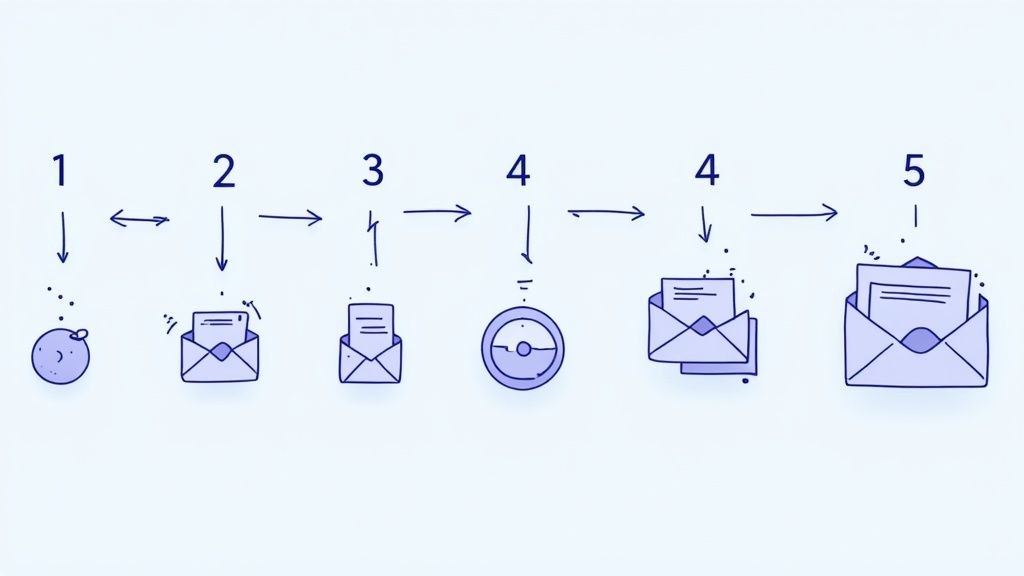
This approach is powerful because it matches your communication cadence to the customer's buying cycle. For example, Grammarly's onboarding drip campaign educates new users on features over several days, boosting activation. Similarly, Dropbox's referral drip campaign reminds users of storage rewards, driving a significant portion of its signups. Platforms like ActiveCampaign and ConvertKit have made building these sophisticated, multi-step workflows accessible to everyone.
How to Implement Drip Campaigns and Nurture Workflows
A successful workflow feels like a helpful, guided conversation, not a robotic sales pitch. The key is strategic planning and a focus on the recipient's journey.
- Map to the Buyer Journey: Design separate workflows for different stages: awareness, consideration, and decision. An awareness stage email might share an educational blog post, while a decision stage email could offer a case study or demo.
- Front-Load Value: Your first few emails are critical for building trust. Start by offering valuable, educational content and save stronger promotional messages for later in the sequence. This keeps recipients engaged rather than pushing them to unsubscribe.
- Set Clear Exit Criteria: Ensure contacts are automatically removed from a nurture sequence once they convert (e.g., make a purchase or book a meeting). Continuing to send nurture emails to a converted customer is a common and avoidable mistake.
- Monitor and Optimize: Pay close attention to drop-off points in your sequence. If many users unsubscribe after the third email, analyze that specific message for relevance, tone, and its call-to-action. Small tweaks can significantly improve overall performance.
4. Behavioral Trigger Automation
One of the most powerful marketing automation best practices is responding to customer actions in real-time. Behavioral trigger automation moves beyond scheduled campaigns by monitoring what users do (or don't do) and initiating a relevant, immediate communication. Instead of sending a message based on a calendar, this approach launches a workflow when a user abandons a cart, visits a specific page, or uses a new feature.
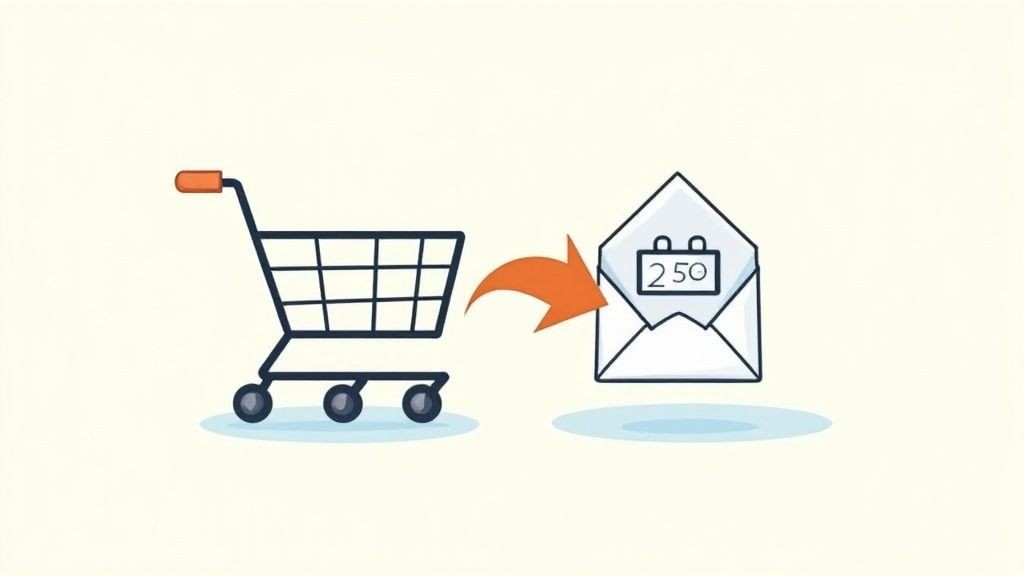
This strategy makes marketing feel less like an interruption and more like a helpful, contextual conversation. It’s what allows Amazon to send its famous "you left items in your cart" emails and Slack to re-engage inactive teams. Platforms like Klaviyo and Intercom have been built around this principle, proving that timely, behavior-based messages generate exceptionally high engagement and conversions. Learn more about how this applies to event marketing in our guide on event marketing automation.
How to Implement Behavioral Trigger Automation
Getting started with triggered workflows means identifying key actions in your customer journey and building automated responses around them.
- Identify High-Value Actions: Pinpoint critical user behaviors that signal intent or disengagement. Common examples include cart abandonment, repeat website visits without converting, or webinar registration without attendance.
- Set Intelligent Time Delays: Don't trigger a message instantly. For an abandoned cart, wait 1-3 hours before sending a reminder; an immediate email can feel intrusive. Test different delays to find the optimal window for your audience.
- Combine Multiple Signals: For higher-quality triggers, require more than one condition. For instance, trigger a workflow only if a user visits the pricing page three times in a week but hasn't started a trial.
- Use Suppressions Wisely: Always suppress triggers for contacts who have recently completed a desired action. Sending a cart abandonment email to someone who just made a purchase creates a poor customer experience.
5. Multi-Channel Campaign Coordination
A truly effective marketing automation strategy extends beyond a single channel like email. Multi-channel campaign coordination is one of the most critical marketing automation best practices for creating a seamless customer journey. It involves orchestrating synchronized messages across various platforms, including email, social media, SMS, and paid ads. Instead of silos, each channel works together to amplify and reinforce a unified message, creating a powerful and cohesive brand experience.
This approach ensures that your audience receives the right message at the right time on the platform they prefer. It transforms disconnected touchpoints into a single, continuous conversation, preventing message fatigue and channel conflict. Platforms like Salesforce Marketing Cloud and Adobe Experience Cloud have championed this integrated approach, demonstrating how coordinated campaigns drive deeper engagement and higher conversions by meeting customers wherever they are.
How to Implement Multi-Channel Coordination
Building a successful multi-channel strategy requires careful planning and a focus on the customer journey. The goal is to create synergy, not noise.
- Map the Customer Journey: Before launching, identify the key stages in your customer's journey. Determine which channels are most effective at each touchpoint, such as using social media for awareness, email for nurturing, and SMS for timely reminders.
- Start Small and Scale: Don't try to master every channel at once. Begin with 2-3 core channels, like email and social media, and build a coordinated workflow. Once you have a proven model, you can layer in additional channels like push notifications or paid retargeting.
- Maintain a Consistent Core Message: While the content should be adapted for each platform's unique format and best practices, the core message, branding, and offer must remain consistent. A customer seeing your ad on Instagram should recognize the same campaign in their email inbox.
- Use Global Frequency Caps: Prevent overwhelming your audience by setting rules that limit the total number of communications a person receives across all channels within a specific period. This protects the customer experience and maintains the effectiveness of your outreach.
6. Data Hygiene and CRM Integration
The most sophisticated automation workflow is useless if it's fueled by bad data. This is why data hygiene and CRM integration stand as a cornerstone among marketing automation best practices. This principle involves maintaining clean, accurate customer data and ensuring it flows seamlessly between your marketing platform and your Customer Relationship Management (CRM) system. Without this foundation, personalization fails, campaigns misfire, and sales and marketing teams operate in disconnected silos.
Effective integration turns your data into a shared source of truth. When a lead's score is updated in HubSpot, it can automatically trigger a sales notification in Salesforce. This closed-loop system allows marketing to prove ROI by tracking which campaigns ultimately generate revenue. Platforms like ZoomInfo and Clearbit further enhance this by automatically enriching profiles with valuable firmographic data, ensuring your automated strategies are always based on the most current information available.
How to Implement Data Hygiene and CRM Integration
Building a clean and connected data ecosystem requires consistent effort and clear processes. The goal is to prevent bad data from entering your system while regularly cleaning what's already there.
- Establish Data Governance: Create clear rules about who can create or edit fields and workflows in your systems. Document your field mapping and sync rules between the CRM and marketing platform to prevent confusion and ensure data consistency.
- Automate List Cleaning: Set up workflows to automatically remove contacts that result in a hard bounce or remain unengaged for a specific period (e.g., 90 days). This keeps your lists healthy and improves your sender reputation.
- Conduct Regular Audits: Schedule quarterly data audits to identify and merge duplicate records, correct formatting errors, and remove outdated contacts. Specialized tools like DemandTools can help automate this otherwise manual process. For a deeper dive into connecting these systems effectively, you can learn more about API integration best practices.
- Use Validation and Progressive Profiling: Implement validation rules on your web forms to prevent incorrect data, like fake email addresses, from ever entering your database. Use progressive profiling on forms to gather information over time, enriching profiles without overwhelming new leads.
7. A/B Testing and Continuous Optimization
Setting up automated workflows is only the first step; a crucial marketing automation best practice is to never treat them as “set and forget.” A/B testing, or split testing, is the data-driven process of comparing two versions of an email, landing page, or workflow to see which one performs better. Continuous optimization means treating your automation strategy as a living process, constantly refining it based on real-world performance data rather than assumptions.
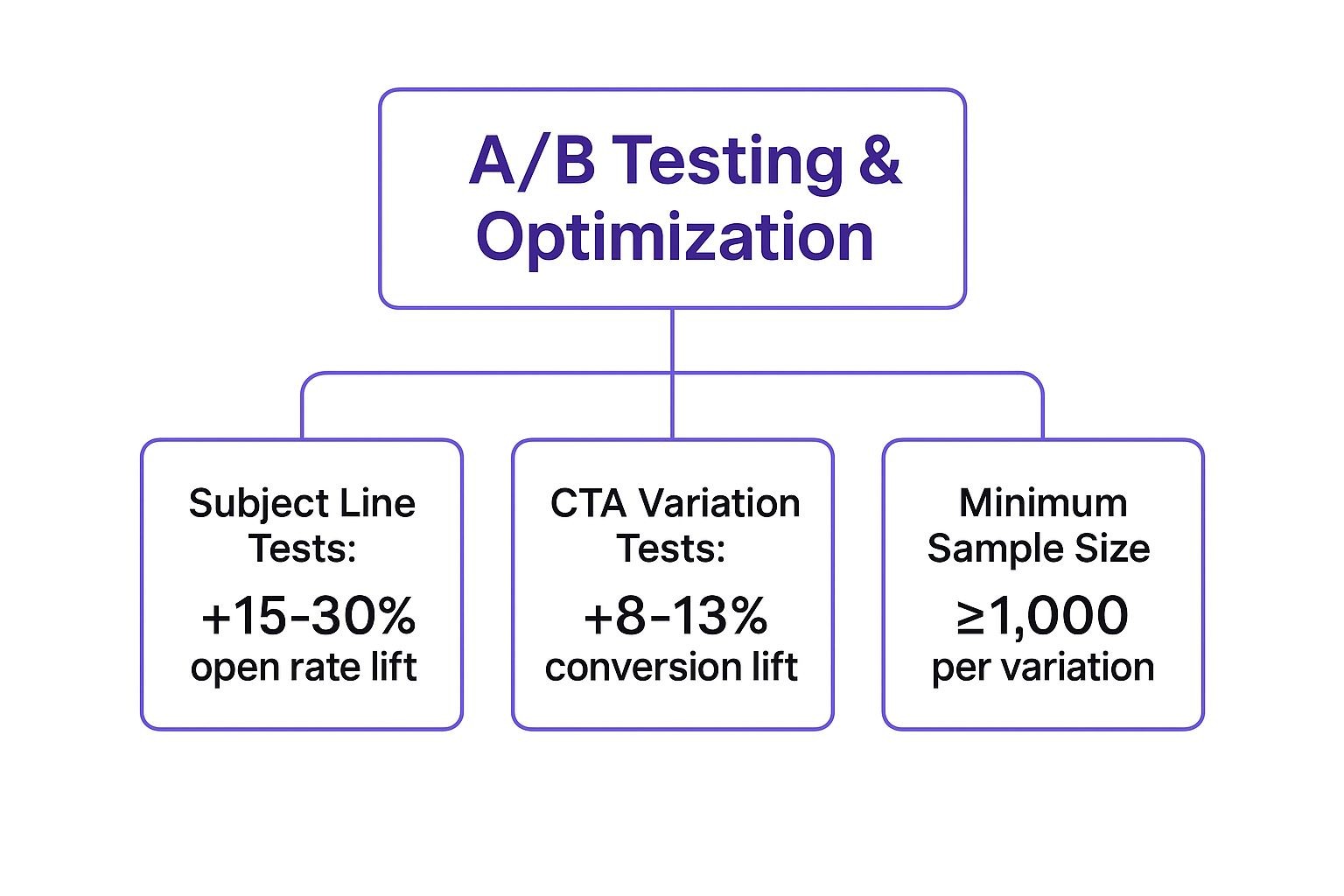
This methodical approach turns marketing from a guessing game into a science, leading to incremental gains that compound over time. Famously, Barack Obama's 2012 campaign raised an additional $60 million through rigorous A/B testing of their email campaigns. This highlights how small, validated changes can produce monumental results.
How to Implement A/B Testing and Optimization
Integrating a testing culture into your automation strategy ensures your efforts become more effective over time. Here’s how to start.
- Test One Variable at a Time: To get clear, actionable results, isolate a single element. Test your subject line OR your call-to-action (CTA), but not both simultaneously. This tells you exactly what change influenced the outcome.
- Focus on High-Impact Elements First: Begin by testing components that have the biggest potential impact on performance. These typically include email subject lines, send times, and CTA button copy or design.
- Ensure Statistical Significance: For your results to be reliable, you need a large enough sample size. A common rule of thumb is to aim for at least 1,000 contacts per variation to make a confident decision.
- Document and Analyze Learnings: Create a central log of all your test results. Don't just note the winner; analyze why it won. Understanding the underlying audience psychology is key to replicating success and is a cornerstone of effective conversion rate optimization.
8. Lifecycle Stage Mapping and Customer Journey Automation
A crucial marketing automation best practice is to align your communications with where a customer is in their journey. Lifecycle stage mapping defines the distinct phases a contact moves through, from initial awareness to loyal advocacy. Automating the customer journey then involves creating specific workflows that deliver the right message at the right time for each stage. Instead of a uniform approach, this strategy acknowledges that a new lead needs different information than a long-time customer.
This methodology ensures your automated efforts feel supportive and relevant, guiding contacts smoothly toward the next milestone. It transforms your marketing from a series of disconnected campaigns into a cohesive, goal-oriented system. Frameworks like HubSpot's lifecycle stages (Subscriber, Lead, MQL, SQL, Customer) and the SiriusDecisions demand waterfall have become industry standards, helping countless businesses orchestrate more meaningful interactions.
How to Implement Lifecycle and Journey Automation
Building effective lifecycle automation requires a strategic, stage-by-stage approach that evolves with your audience.
- Define Your Core Stages: Start by outlining 5-7 key stages that represent your typical customer journey. For example, an e-commerce brand might use: Browser → Prospect → First-Time Buyer → Repeat Customer → VIP. Avoid over-complicating it with too many micro-stages initially.
- Establish Clear Progression Criteria: For each stage, define the specific, measurable actions that move a contact forward. A lead might become a Marketing Qualified Lead (MQL) after downloading a bottom-of-funnel resource like a pricing guide or case study.
- Map Content to Each Stage: Create an inventory of your content and offers, assigning each to a lifecycle stage. Early stages need educational content (blog posts, guides), middle stages require solution-focused assets (webinars, demos), and late stages benefit from validation content (case studies, ROI calculators). This process also reveals content gaps you need to fill.
- Build Stage-Specific Workflows: Design automated workflows to nurture contacts within each stage and trigger advancement to the next. For instance, a new "Customer" could be enrolled in an onboarding sequence, while a "VIP" receives exclusive offers and early access to new products.
Best Practices Comparison of 8 Marketing Automation Strategies
| Item | Implementation Complexity 🔄 | Resource Requirements ⚡ | Expected Outcomes 📊 | Ideal Use Cases 💡 | Key Advantages ⭐ |
|---|---|---|---|---|---|
| Audience Segmentation and Personalization | Medium-High: requires data setup and ongoing refinement | High: needs customer data, automation tools, CRM integration | Improved engagement, +14% open rates, higher conversion | Targeted campaigns for diverse customer bases | Highly relevant messaging, budget efficiency |
| Lead Scoring and Qualification | Medium-High: complex scoring models, requires sales-marketing alignment | Medium-High: historical data, collaboration across teams | Increases sales efficiency 20-30%, shorter sales cycles | Prioritizing sales-ready leads, B2B sales focus | Data-driven lead prioritization, alignment boost |
| Drip Campaigns and Nurture Workflows | Medium: upfront planning and content creation required | Medium: content production, automation platform | 50% better conversion, 80% more sales at 33% lower cost | Customer onboarding, education, long-term nurturing | Consistent communication, workload reduction |
| Behavioral Trigger Automation | High: technical setup, multi-channel tracking needed | High: robust tracking infrastructure, integration tools | 70% higher open rates, 10-30% cart recovery | Real-time personalized responses, e-commerce | Highly contextual, timely messaging |
| Multi-Channel Campaign Coordination | Very High: complex orchestration across platforms | Very High: multi-platform integration, content creation | 250% higher purchase rates, improved brand recall | Omnichannel marketing, large-scale campaigns | Unified customer experience, channel synergy |
| Data Hygiene and CRM Integration | Medium-High: ongoing maintenance, complex integrations | Medium-High: tools for cleaning, enrichment, sync setup | 66% higher opportunity-to-win rates, lower bounce rates | Maintaining accurate data, enhancing CRM-automation sync | Accurate targeting, sales-marketing alignment |
| A/B Testing and Continuous Optimization | Medium: requires careful experiment design and data analysis | Medium: testing platforms, sufficient sample size | Open rates improved 15-30%, incremental conversion gains | Campaign optimization, data-driven decision making | Removes guesswork, fosters experimentation culture |
| Lifecycle Stage Mapping and Customer Journey Automation | Medium-High: mapping stages, cross-team coordination | Medium: workflow automation, content tailored to stages | Generates 45% more leads at 33% lower cost | Managing customer journey with stage-specific messaging | Increased relevance, better forecasting and pipeline control |
Putting Your Automation Strategy into Action
We have journeyed through the core pillars of a successful automation strategy, moving beyond simple scheduled emails into a realm of intelligent, responsive marketing. The principles covered, from granular audience segmentation and precise lead scoring to dynamic behavioral triggers and continuous A/B testing, are not just individual tactics. They are interconnected components of a powerful marketing engine designed to deliver the right message to the right person at the right time.
True mastery of marketing automation is not a "set it and forget it" task; it's an ongoing process of refinement and adaptation. By implementing these marketing automation best practices, you transform your efforts from a series of disjointed campaigns into a cohesive, orchestrated customer journey. The goal is to build a system that not only saves time but also creates meaningful, personalized experiences that drive loyalty and conversions.
From Theory to Tangible Results
The real value emerges when you put these concepts into practice. For instance, combining lifecycle stage mapping with multi-channel coordination ensures your communication evolves alongside your customer relationship, meeting them on their preferred platforms with relevant content. Likewise, robust data hygiene and CRM integration are the foundation upon which all effective personalization and lead scoring are built. Without clean, reliable data, even the most sophisticated workflows will falter.
A great place to start is with high-impact, time-sensitive communications, like those surrounding events, webinars, or product launches. This is where automation truly shines. A personalized reminder sequence, triggered by a user's behavior, can dramatically increase attendance and engagement. This is a practical, measurable way to see the immediate benefits of a well-honed automation strategy.
Your Next Steps to Automation Excellence
Instead of trying to overhaul your entire system at once, focus on incremental improvements. Choose one or two of the best practices we've discussed to focus on this quarter.
- Audit Your Data: Is your CRM data clean and properly integrated? Start here to build a solid foundation.
- Refine a Key Workflow: Select your most important lead nurturing drip campaign and apply A/B testing principles to optimize open rates or click-throughs.
- Enhance Event Engagement: Integrate automated event reminders into your campaigns to see a direct lift in participation for your next webinar or conference.
By concentrating your efforts, you can achieve tangible wins that build momentum and demonstrate the ROI of your automation investments. Remember, the ultimate objective is to create a more efficient, effective, and customer-centric marketing ecosystem. Each refined workflow and every clean data point moves you closer to that goal, transforming your automation platform from a simple tool into your most valuable strategic asset.
Ready to seamlessly integrate powerful event marketing into your automated workflows? Our service provides the essential link, allowing your audience to add events to their calendars with a single click, boosting attendance and engagement for your webinars, conferences, and promotions. Explore how Add to Calendar PRO can enhance your marketing automation best practices today.
